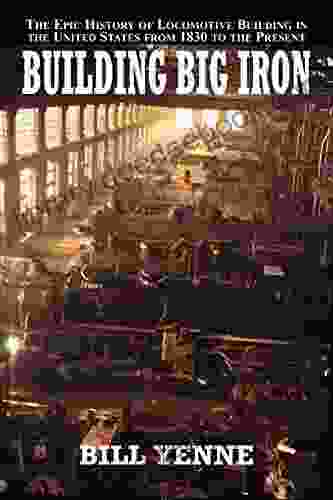The Epic History of Locomotive Building in the United States: A Comprehensive Journey from 1830 to the Present


The locomotive has played a pivotal role in the development and expansion of the United States, transforming transportation and revolutionizing the way people lived and worked. The history of locomotive building in the United States is a rich and fascinating tale of ingenuity, innovation, and industrial prowess. This comprehensive article delves into the key events, technological advancements, and leading companies that have shaped this vital industry from its inception in the 1830s to the present day.
4 out of 5
| Language | : | English |
| File size | : | 4174 KB |
| Text-to-Speech | : | Enabled |
| Screen Reader | : | Supported |
| Enhanced typesetting | : | Enabled |
| Print length | : | 123 pages |
| Lending | : | Enabled |
The Early Years: 1830-1860
The dawn of locomotive building in the United States coincided with the birth of the nation's railroad system. In 1830, the "Tom Thumb," designed by Peter Cooper, became the first successful steam locomotive to operate in the United States. This humble beginning marked the start of an industry that would rapidly transform transportation and the country's economy.
Over the next few decades, numerous inventors and entrepreneurs experimented with locomotive designs, seeking to improve efficiency, power, and speed. Notable figures included Matthias Baldwin, who founded the Baldwin Locomotive Works in 1825, and George Stephenson, whose "Rocket" locomotive showcased the potential of steam power in 1829.
The Civil War Era: 1861-1865
The American Civil War had a profound impact on locomotive building in the United States. The conflict created an unprecedented demand for locomotives to transport troops, supplies, and equipment. Both the Union and Confederate governments placed large orders with locomotive manufacturers, leading to a surge in production and innovation.
During this period, several new locomotive designs emerged, including the "American" type, which featured a 4-4-0 wheel arrangement and became the standard design for passenger locomotives. The war also accelerated the development of specialized locomotives, such as the "Monitor" class, designed to tow armored warships.
The Post-Civil War Era: 1865-1890
Following the Civil War, the railroad industry experienced a period of rapid expansion and consolidation. Major railroad companies emerged, such as the Pennsylvania Railroad, the New York Central Railroad, and the Union Pacific Railroad. These companies placed large orders for locomotives, driving further growth in the industry.
Technological advancements during this period included the development of the "Mogul" type locomotive, which had a 2-6-0 wheel arrangement and was designed for heavy freight hauling. The of the air brake by George Westinghouse in 1869 greatly improved safety and efficiency in railroad operations.
The Turn of the Century: 1890-1920
The late 19th and early 20th centuries witnessed a golden age of locomotive building in the United States. The industry reached its peak in 1907, when over 6,000 locomotives were produced. This period saw the emergence of new locomotive designs, such as the "Santa Fe" type, which had a 2-10-2 wheel arrangement and was designed for hauling heavy trains over mountain passes.
Several major locomotive manufacturers emerged during this period, including the American Locomotive Company (ALCo),the Baldwin Locomotive Works, and the Lima Locomotive Works. These companies competed fiercely for market share, driving innovation and technological advancements.
The Diesel Era: 1920-1960
The early 20th century marked the transition from steam to diesel locomotives. Diesel engines offered several advantages over steam engines, including greater efficiency, lower maintenance costs, and reduced pollution. The first successful diesel locomotive was built by the Electro-Motive Division of General Motors in 1935.
Over the next few decades, diesel locomotives gradually replaced steam locomotives on the nation's railroads. By the 1960s, steam locomotives had all but disappeared from regular service. The diesel era brought about new locomotive designs, such as the "F" series and "PA" series locomotives, which became synonymous with American railroading.
The Modern Era: 1960-Present
The modern era of locomotive building in the United States has been characterized by continued technological advancements and globalization. The of electronic controls, microprocessors, and computer-aided design has significantly improved locomotive performance and efficiency.
In recent years, the industry has witnessed the emergence of new locomotive manufacturers, particularly from China and other countries. Competition has intensified, driving innovation and cost-effectiveness. Today, a wide range of locomotive types are available, tailored to meet the specific needs of different railroad operations.
The history of locomotive building in the United States is a testament to the ingenuity, innovation, and industrial prowess of the American people. From the humble beginnings of the "Tom Thumb" to the advanced diesel-electric locomotives of today, the locomotive has played a vital role in shaping the nation's transportation system and economy.
As the railroad industry continues to evolve, it is likely that new locomotive technologies and designs will emerge to meet the changing demands of the future. The legacy of locomotive building in the United States will undoubtedly continue to inspire generations to come.
4 out of 5
| Language | : | English |
| File size | : | 4174 KB |
| Text-to-Speech | : | Enabled |
| Screen Reader | : | Supported |
| Enhanced typesetting | : | Enabled |
| Print length | : | 123 pages |
| Lending | : | Enabled |
Do you want to contribute by writing guest posts on this blog?
Please contact us and send us a resume of previous articles that you have written.
 Book
Book Novel
Novel Page
Page Genre
Genre Reader
Reader Library
Library Paperback
Paperback Magazine
Magazine Sentence
Sentence Bookmark
Bookmark Shelf
Shelf Glossary
Glossary Bibliography
Bibliography Synopsis
Synopsis Annotation
Annotation Codex
Codex Tome
Tome Classics
Classics Narrative
Narrative Biography
Biography Autobiography
Autobiography Reference
Reference Encyclopedia
Encyclopedia Thesaurus
Thesaurus Character
Character Resolution
Resolution Card Catalog
Card Catalog Borrowing
Borrowing Stacks
Stacks Periodicals
Periodicals Research
Research Lending
Lending Reserve
Reserve Academic
Academic Reading Room
Reading Room Rare Books
Rare Books Interlibrary
Interlibrary Literacy
Literacy Book Club
Book Club Theory
Theory Matson Taylor
Matson Taylor United States Government Us Army
United States Government Us Army Wayne Errington
Wayne Errington Robert Neubecker
Robert Neubecker J R Erickson
J R Erickson Jeremy P Bushnell
Jeremy P Bushnell Narendra Malhotra
Narendra Malhotra Gianluca Manzo
Gianluca Manzo David F Musto
David F Musto Pedro Murino Almeida
Pedro Murino Almeida Johann David Wyss
Johann David Wyss John W Budd
John W Budd Liao Yiwu
Liao Yiwu Henrik Vejlgaard
Henrik Vejlgaard Jose Luis Hinojosa
Jose Luis Hinojosa John Lohman
John Lohman Bob Costello
Bob Costello Becky Gillespie
Becky Gillespie Hyatt Saleh
Hyatt Saleh Emily Woods
Emily Woods
Light bulbAdvertise smarter! Our strategic ad space ensures maximum exposure. Reserve your spot today!

 Deion SimmonsLove, Death, and Country Music: A Captivating Exploration of Music's Timeless...
Deion SimmonsLove, Death, and Country Music: A Captivating Exploration of Music's Timeless... Gilbert CoxFollow ·14.6k
Gilbert CoxFollow ·14.6k Vic ParkerFollow ·13.1k
Vic ParkerFollow ·13.1k Noah BlairFollow ·4.7k
Noah BlairFollow ·4.7k J.R.R. TolkienFollow ·2.3k
J.R.R. TolkienFollow ·2.3k Harrison BlairFollow ·4.9k
Harrison BlairFollow ·4.9k Elton HayesFollow ·18.3k
Elton HayesFollow ·18.3k Greg CoxFollow ·15.9k
Greg CoxFollow ·15.9k Charles ReedFollow ·17.3k
Charles ReedFollow ·17.3k

 Ralph Ellison
Ralph EllisonHealth Care Global Viewpoints: Samantha Whiskey
Samantha Whiskey is a global health...

 Gabriel Garcia Marquez
Gabriel Garcia MarquezTeacher Educators' Reflections on Culturally Relevant...
In today's...

 Levi Powell
Levi PowellSustainable Project Management: The GPM Reference Guide...
In today's rapidly changing world,...

 Isaac Bell
Isaac BellThe Captivating World of "Dreaming Awake Falling Under"
A Journey Through...

 Clarence Brooks
Clarence BrooksGovernance Regulations Valuations Mergers And...
In today's complex and ever-changing...
4 out of 5
| Language | : | English |
| File size | : | 4174 KB |
| Text-to-Speech | : | Enabled |
| Screen Reader | : | Supported |
| Enhanced typesetting | : | Enabled |
| Print length | : | 123 pages |
| Lending | : | Enabled |












